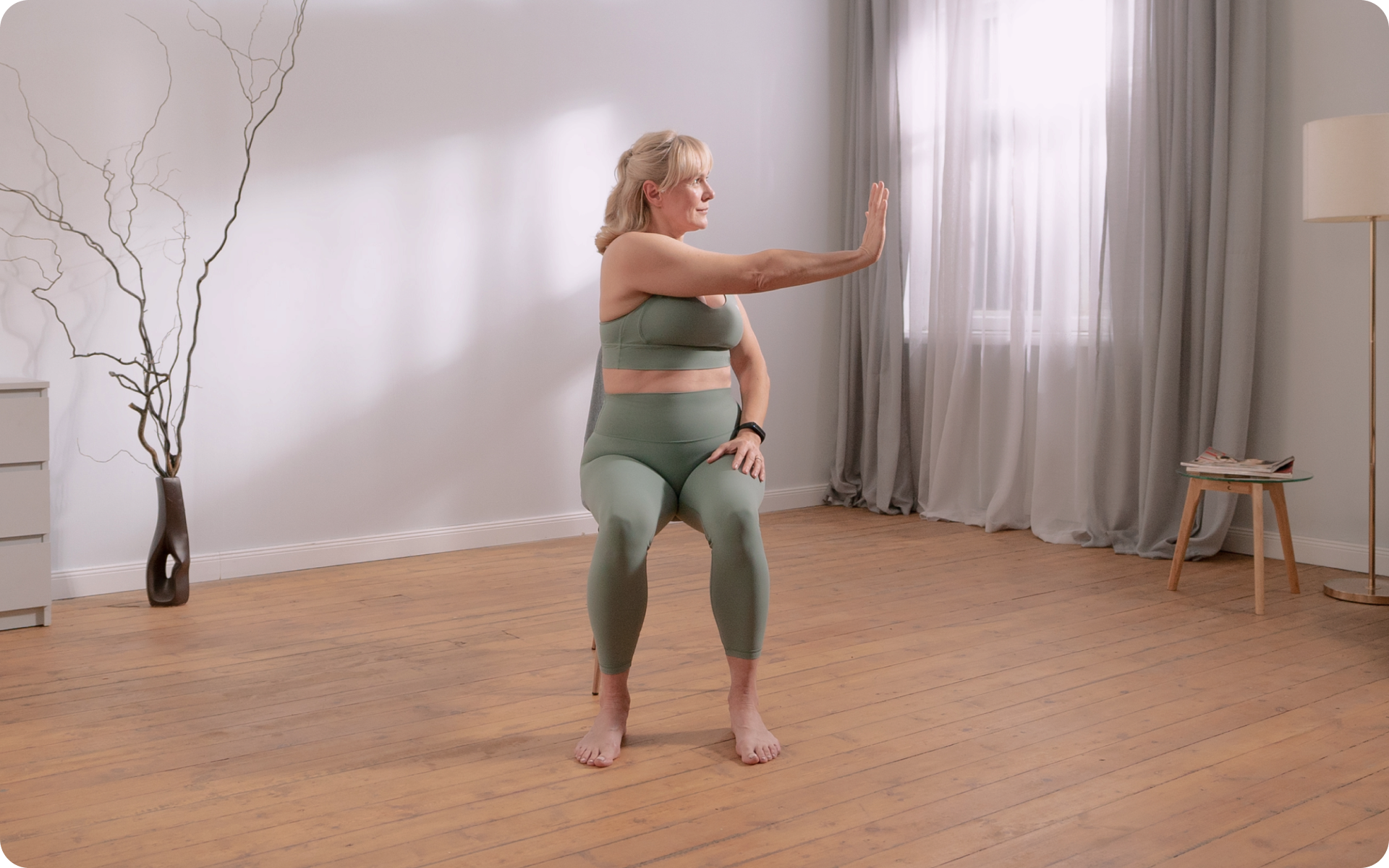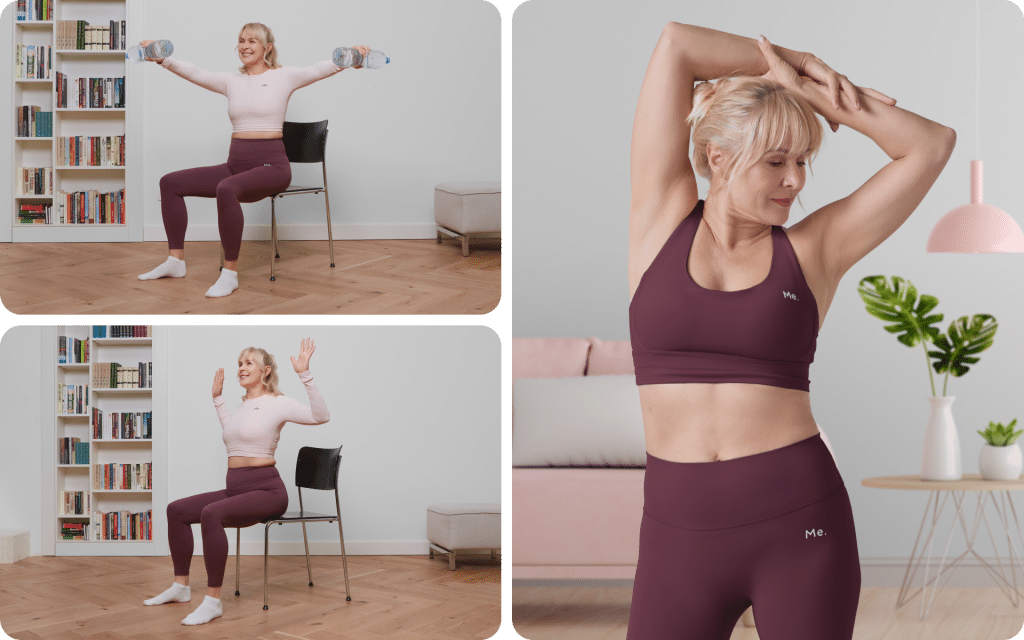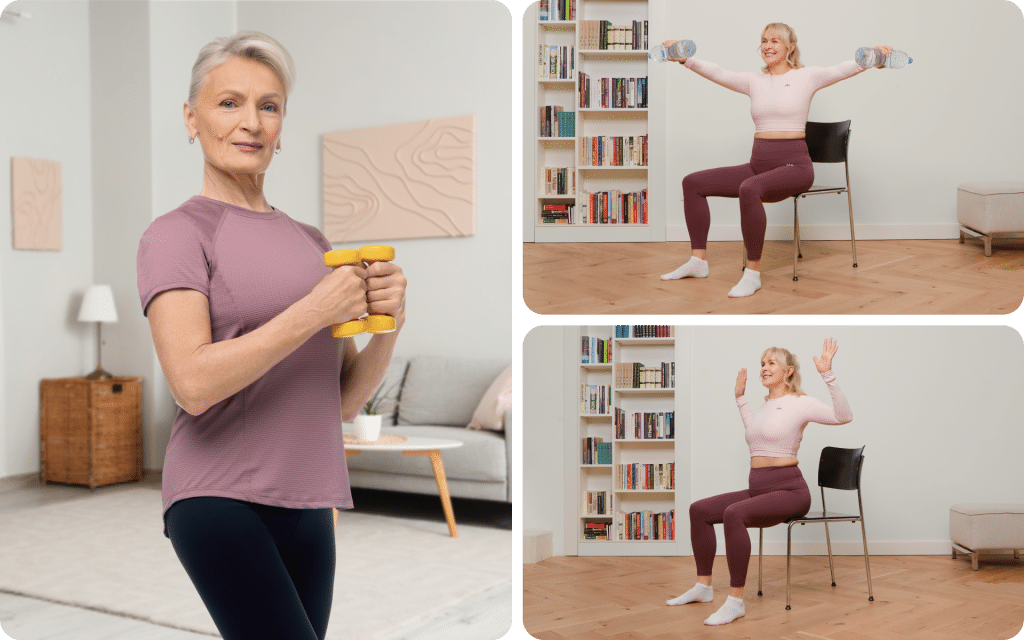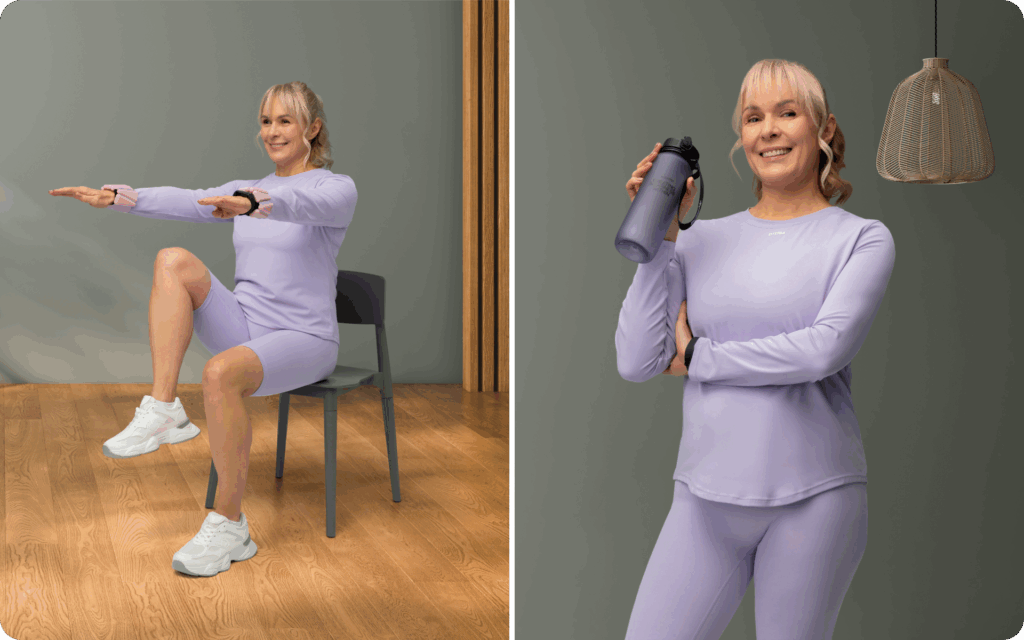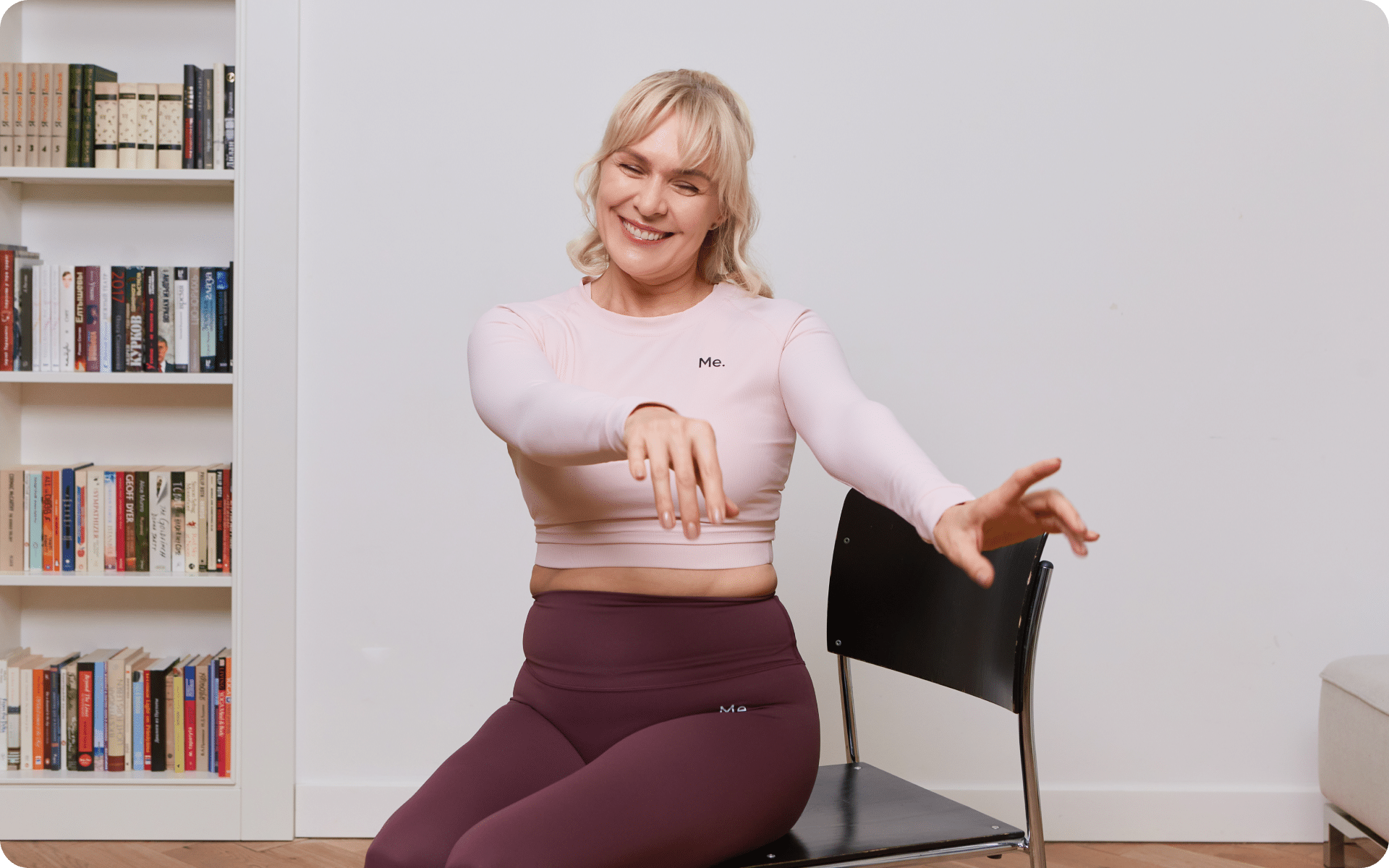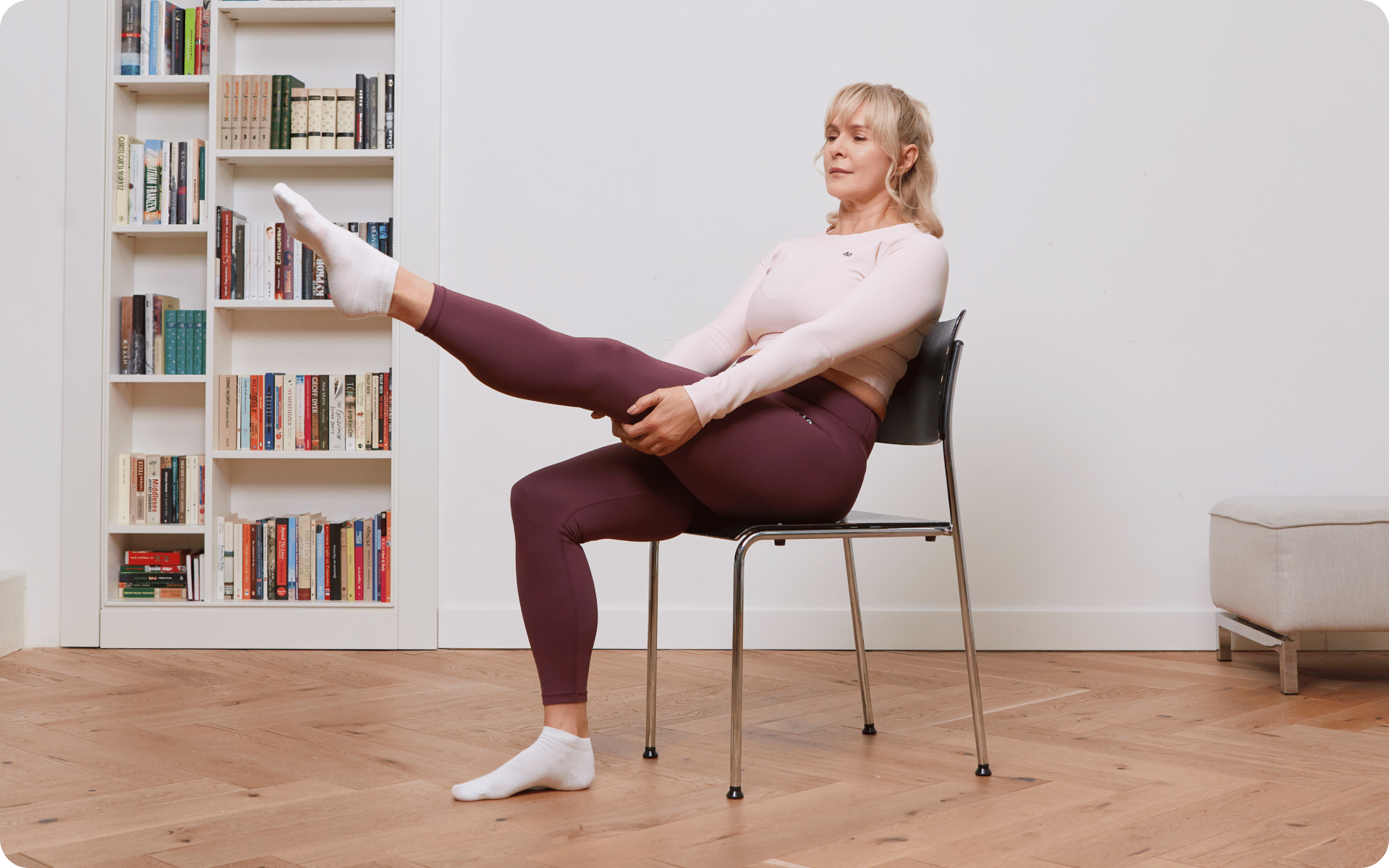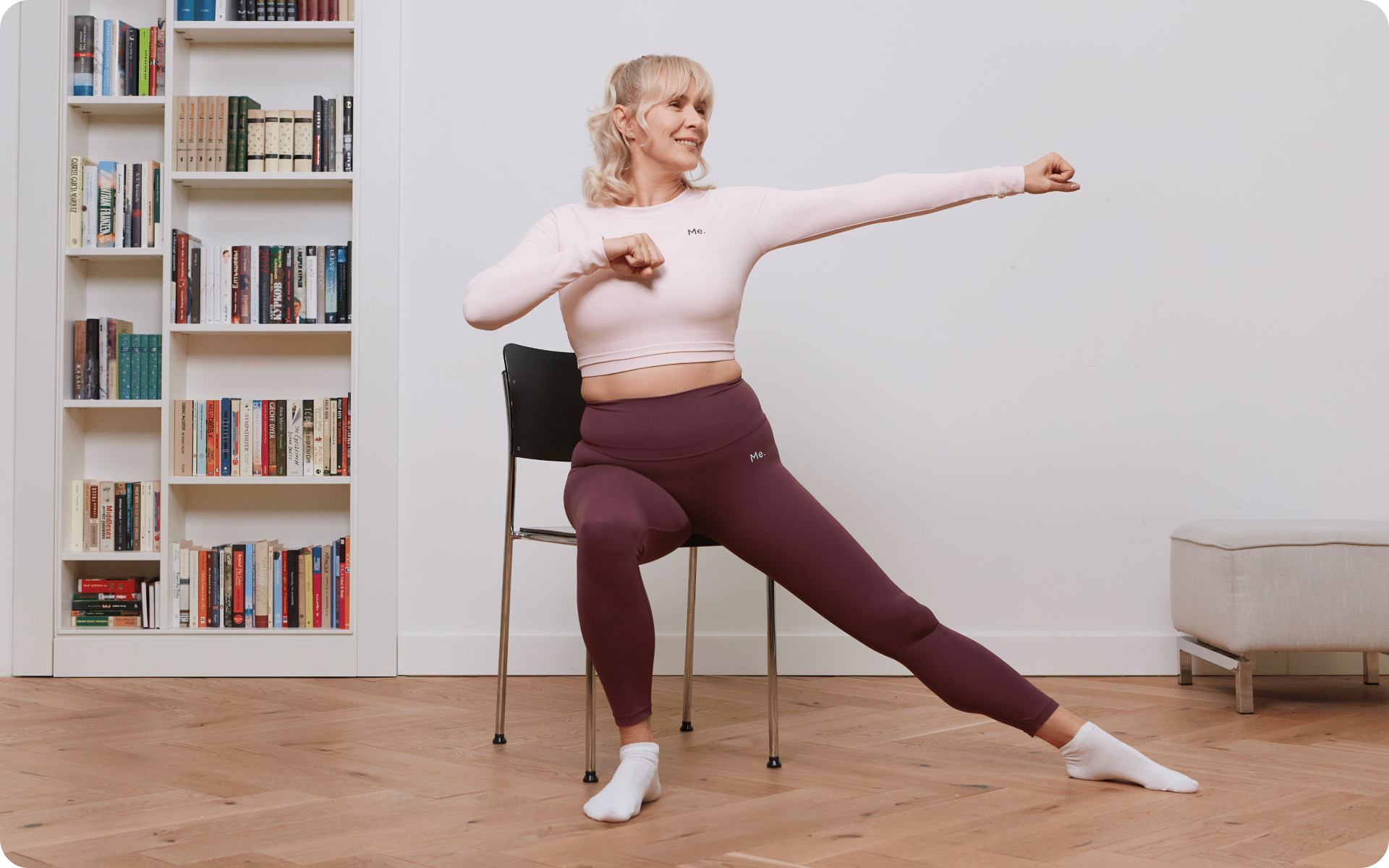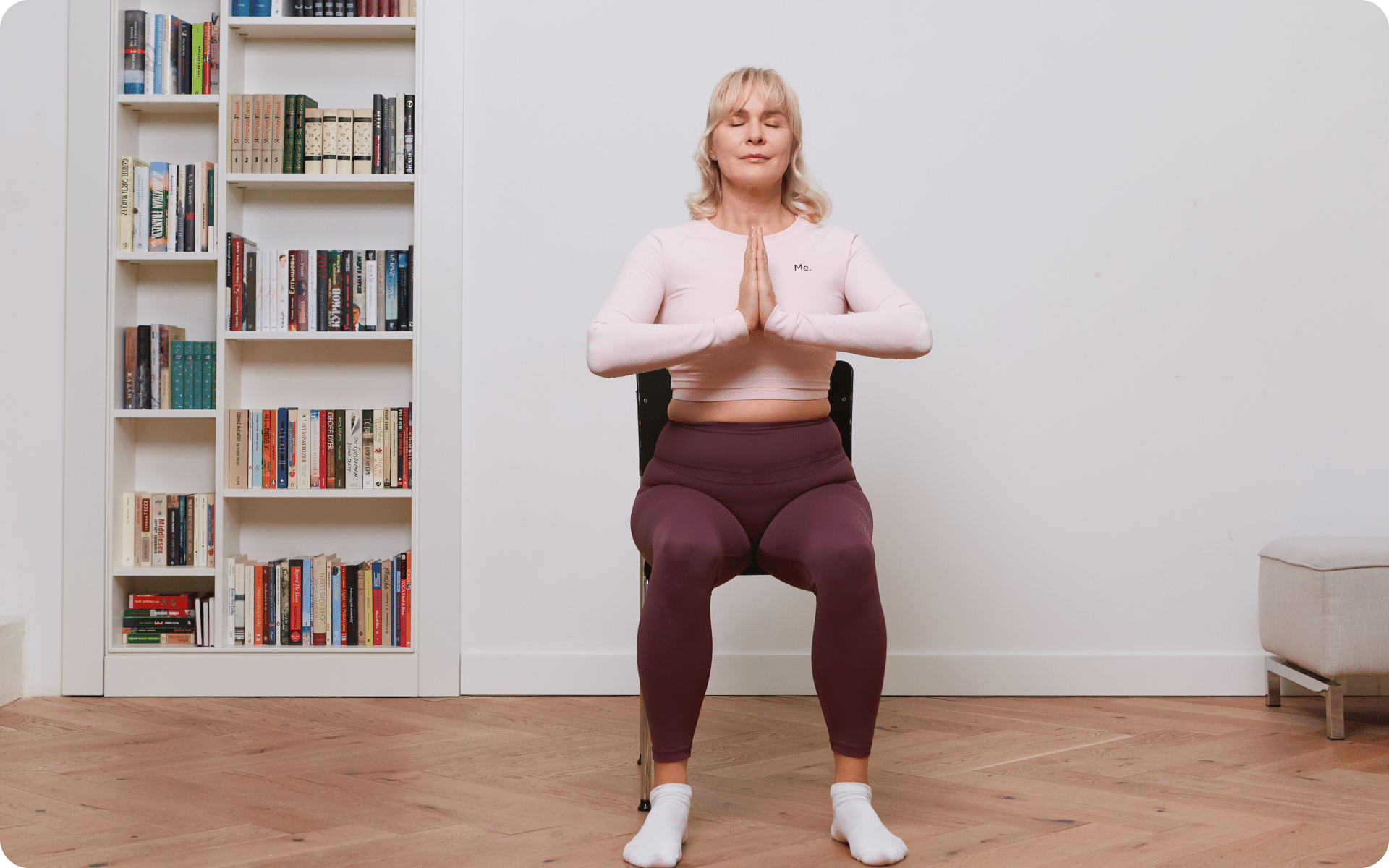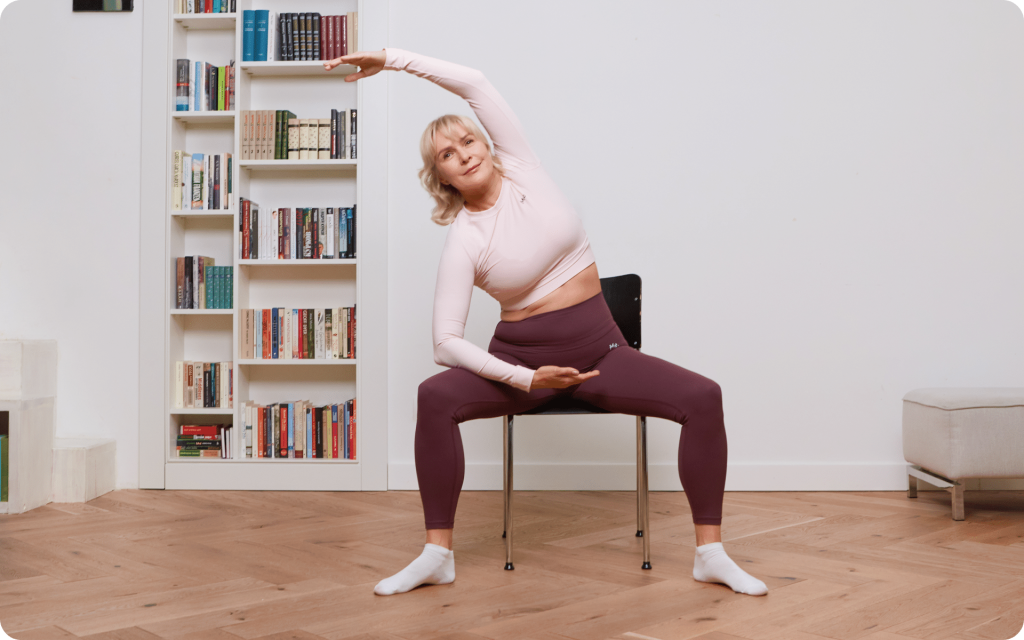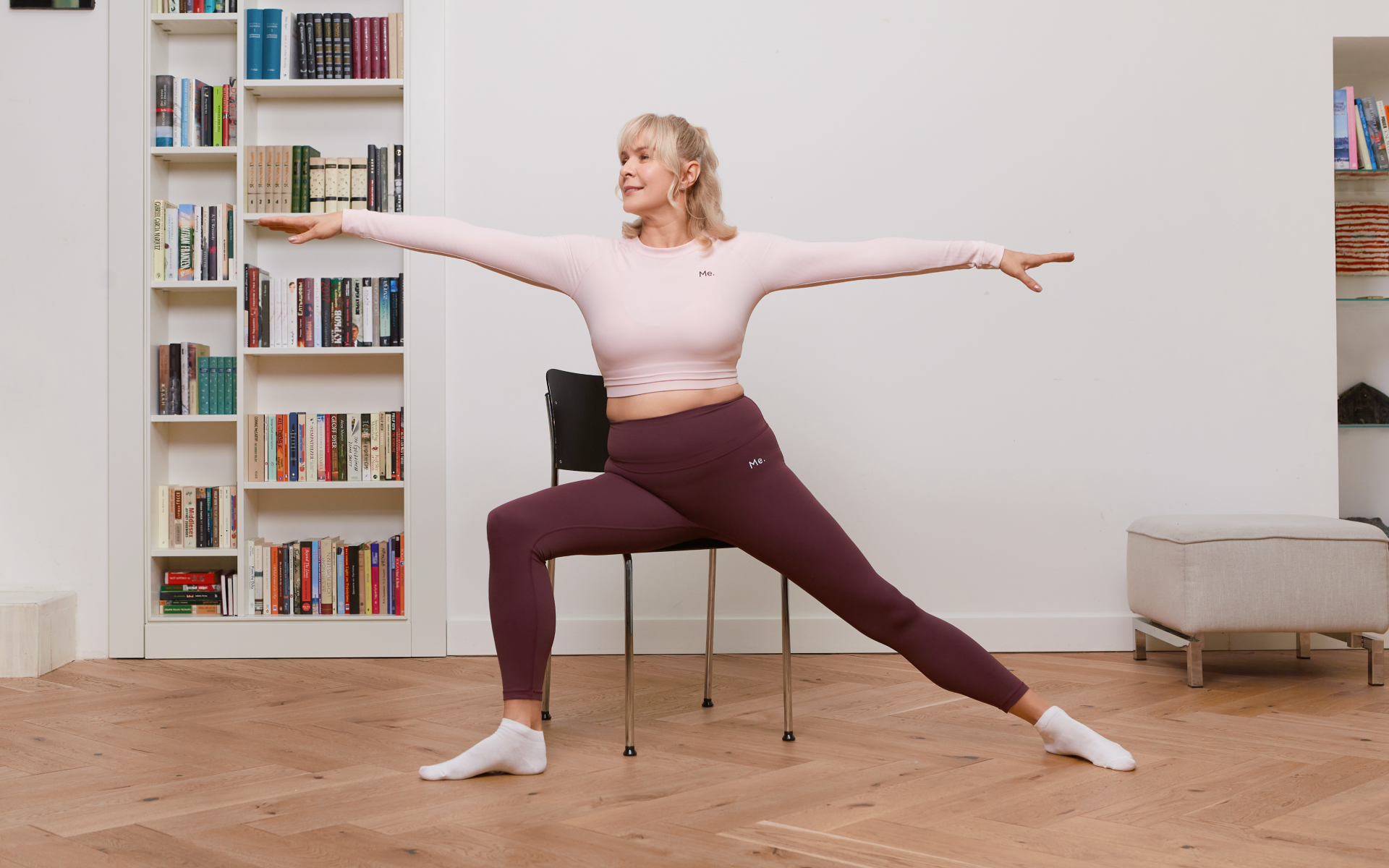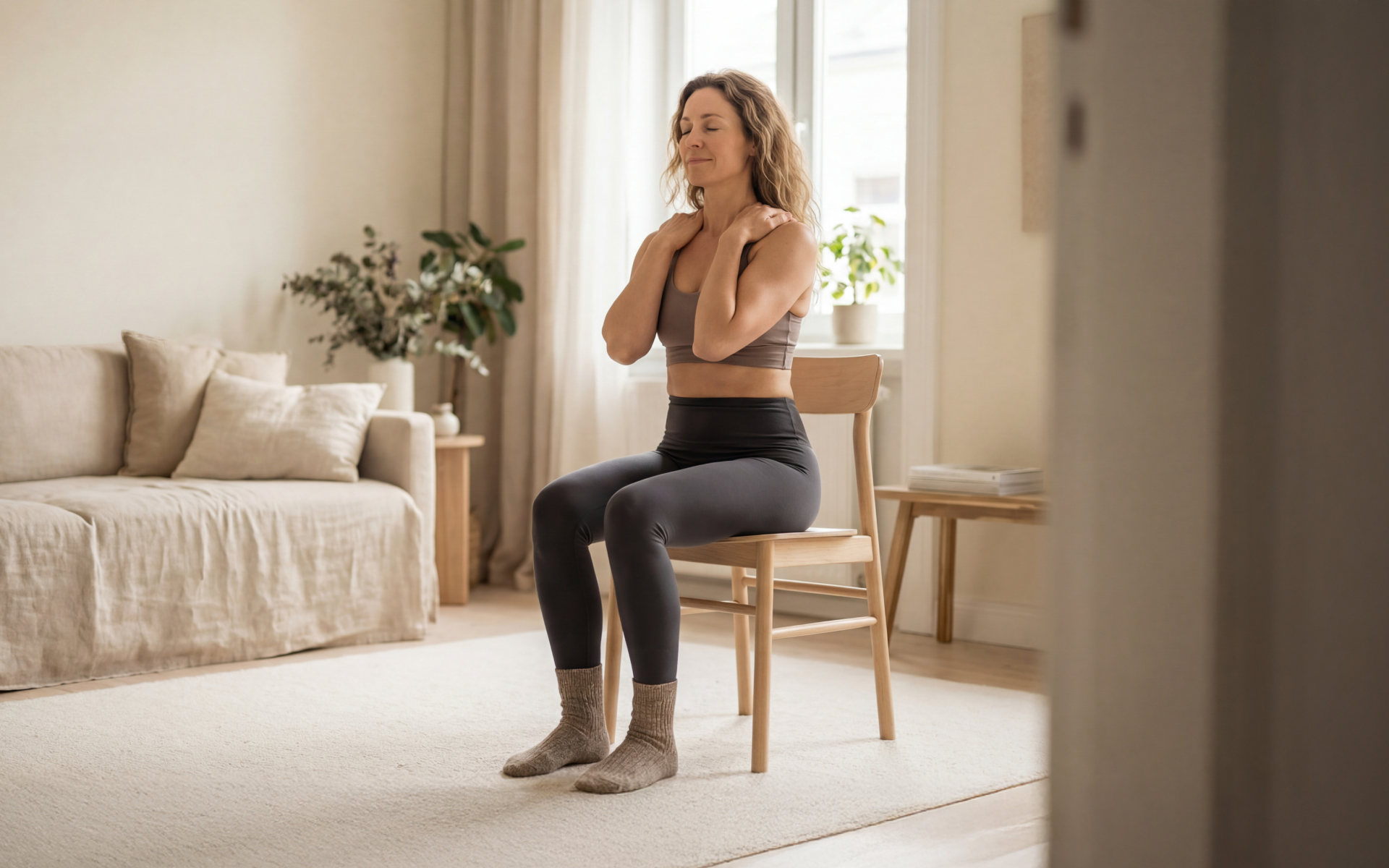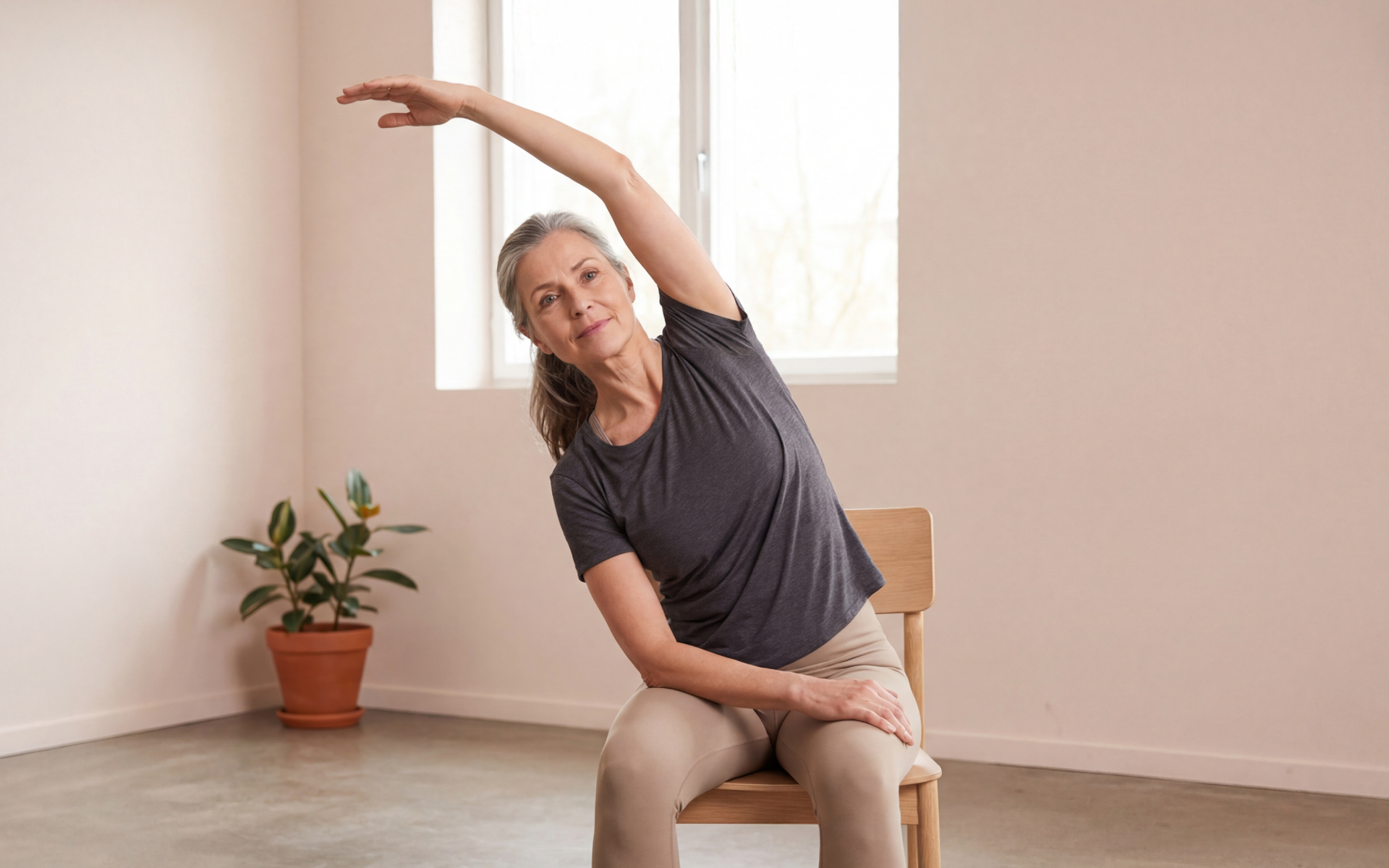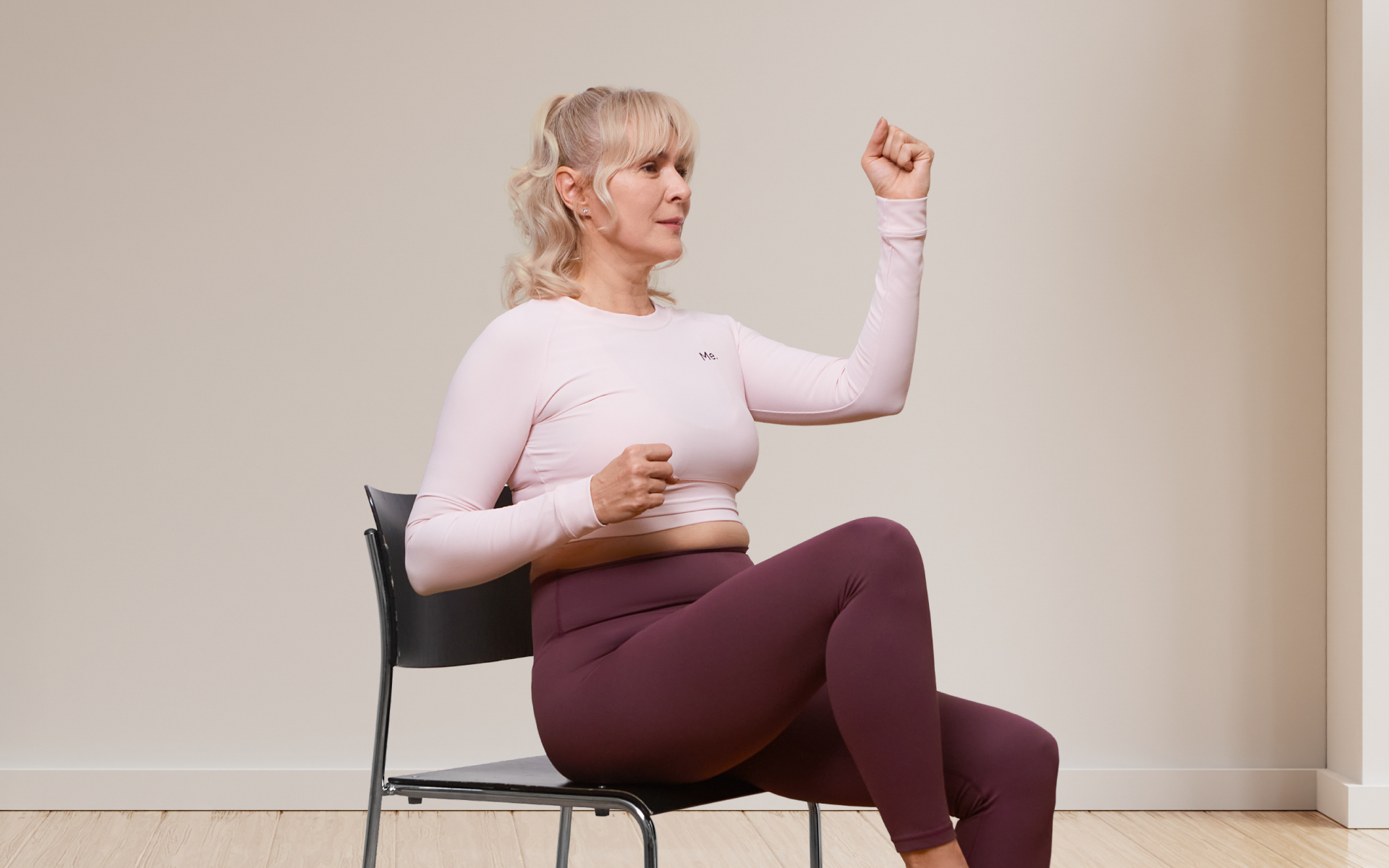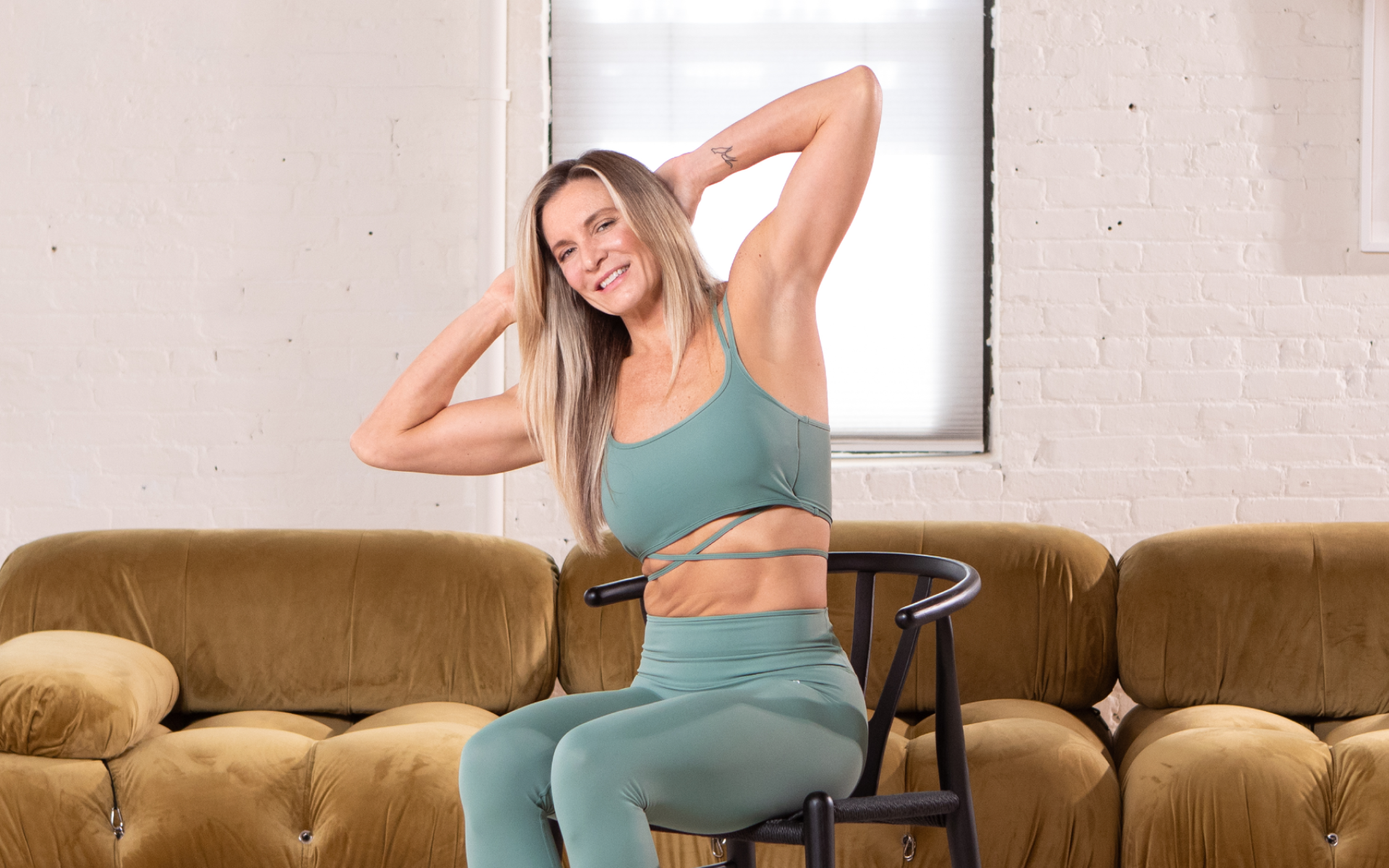The American Geriatrics Society emphasizes the importance of regular movement for older adults (1). The National Institute on Aging agrees, recommending activities that improve flexibility, strength, and balance while minimizing the risk of injury (2).
Chair yoga, a modified form of traditional yoga, is perfectly aligned with these recommendations. By adapting poses to be performed while seated or using a chair for support, this practice offers a safe, accessible way for seniors to engage in physical activity, regardless of their fitness level or mobility.
In this article, we’ll explore 10 chair yoga positions that are specifically designed for seniors.
What Is the Number One Exercise Seniors Should Do?
While it’s impossible to crown a single exercise as universally the “best” for seniors, walking stands out as a top contender due to its numerous benefits, which include:
- Accessibility
- Versatility
- Comprehensive health benefits.
As it’s a weight-bearing activity, it also provides a variety of crucial fitness benefits, including:
- Engages multiple muscle groups
- Promotes cardiovascular health
- Supports bone density
These are all critical factors for aging populations (3).
That being said, the best exercise for seniors is ultimately one that they enjoy and can consistently incorporate into their routines. Whether it’s walking, swimming, yoga, or something else entirely, staying active is the key to maintaining physical and mental well-being as you age.
Read more: 3 Best Exercises to Lose Belly Fat After 50 for Women
Is Chair Yoga a Good Exercise for Seniors?
Chair yoga is suitable for seniors for many reasons:
1. Low Impact on Joints
Chair yoga is inherently gentle, which makes it an excellent choice for seniors with joint issues such as osteoarthritis (4). Unlike high-impact exercises, which can exacerbate joint pain or inflammation, chair yoga minimizes stress on weight-bearing joints while still promoting movement. This suitability is aligned with recommendations from the Arthritis Foundation, which advocates for low-impact activities to maintain joint health without overloading them (5).
2. Adaptable to Physical Limitations
One of the key advantages of chair yoga is its adaptability. Movements can be modified to accommodate a wide range of physical abilities, from those with limited mobility to individuals recovering from surgery or illness.
The use of a chair for support ensures that seniors can participate safely, even if they struggle with balance or strength, which makes it an inclusive option for diverse needs.
3. Safe for Balance and Fall Prevention
Falls are a leading concern for older adults, often resulting in serious injuries. Chair yoga provides a stable environment for practicing balance-enhancing movements without the risk of falling (6).
By incorporating seated or supported poses, seniors can work on improving their proprioception (body awareness) and stability in a safe and controlled manner.
Reasons why BetterMe is a safe bet: a wide range of calorie-blasting workouts, finger-licking recipes, 24/7 support, challenges that’ll keep you on your best game, and that just scratches the surface! Start using our app and watch the magic happen.
4. Encourages Gentle Range of Motion
Maintaining joint flexibility and range of motion is essential for seniors to perform daily activities comfortably. Chair yoga emphasizes slow, deliberate movements that gently guide joints through their natural range of motion.
This approach reduces stiffness and promotes functional mobility without the risk of overextension or strain (4). To learn more about the seated yoga stretches, check out our in-depth article on the topic.
5. Supports Cardiovascular Health Without Overexertion
While chair yoga isn’t a high-intensity workout, just like conventional yoga, it can still provide light cardiovascular benefits. Movements are often synchronized with deep, controlled breathing, which can improve circulation and oxygen delivery throughout the body (7).
This makes it a suitable option for seniors who may not tolerate more vigorous forms of exercise due to heart or respiratory conditions.
6. Minimizes Risk of Overexertion
For seniors, overexertion during exercise can result in several dangerous responses, including:
- Fatigue
- Dizziness
- Injury
The slow pace of chair yoga and its focus on mindfulness allow participants to move at their own comfort level.
This self-paced nature ensures individuals can engage in physical activity without pushing beyond their limits, which is particularly important for those who are managing chronic conditions.
7. Accessible for Beginners
Many seniors may feel intimidated by traditional fitness classes or gym environments. Chair yoga offers a welcoming, beginner-friendly alternative that doesn’t require previous experience or advanced physical fitness.
The simplicity of the movements, combined with the supportive structure of a chair, makes it an approachable starting point for those new to exercise.
8. Promotes Consistency Through Comfort
Consistency is a cornerstone of any effective exercise routine, and chair yoga’s comfort and ease of practice encourage regular participation.
Unlike more strenuous activities that may feel daunting or unsustainable, chair yoga can be performed daily without significant physical strain, fostering long-term adherence.
9. Integrates Mind-Body Connection
The emphasis of chair yoga on mindfulness and controlled breathing is aligned with the growing body of research highlighting the benefits of mind-body practices for seniors (8).
By combining gentle movement with mental focus, chair yoga supports both physical and cognitive health, which makes it a well-rounded exercise option for this population.
What Are the Main Benefits of Chair Yoga for Seniors?
1. Improves Joint Flexibility and Mobility
Chair yoga gently encourages movement in the joints, helping maintain or improve their range of motion. This is particularly beneficial for seniors with arthritis or stiffness, as regular, controlled movement can reduce joint discomfort and improve overall mobility.
Studies have shown that low-impact exercises such as yoga can help lubricate joints and prevent further deterioration (7). Uncover the surprising benefits of restorative yoga poses in our past article.
2. Enhances Muscle Strength
While chair yoga may appear gentle, it engages key muscle groups, particularly in the legs and arms. Strengthening these muscles is essential for maintaining functional independence in daily activities, such as standing up from a chair or carrying groceries.
Improved muscle strength also supports better posture and reduces the risk of falls (9).
3. Boosts Circulation and Cardiovascular Health
The combination of movement and controlled breathing in yoga promotes better blood flow throughout the body.
Improved circulation supports cardiovascular health, aids in oxygen delivery to tissues in older adults (10).
4. Supports Balance and Coordination
Chair yoga incorporates movements that challenge balance and coordination in a safe, controlled environment. By improving proprioception (the body’s sense of its position in space), seniors can enhance their ability to react to changes in their environment, which reduces the likelihood of falls and injuries (11).
5. Reduces Stress and Promotes Relaxation
The mindfulness component of chair yoga, which emphasizes deep breathing and present-moment awareness, has been shown to lower cortisol levels – the body’s primary stress hormone.
This can lead to a greater sense of calm, reduced stress, and improved overall mental well-being (12).
6. Improves Cognitive Function
Emerging research has highlighted the connection between physical activity and brain health (13).
With its focus on coordination, breathing, and mindfulness, chair yoga stimulates the brain and supports neuroplasticity – the brain’s ability to adapt and form new connections. This results in:
- Enhanced memory
- Greater focus
- Increased cognitive resilience
All of these improve the cognitive function of seniors.
7. Alleviates Chronic Pain
For seniors who are dealing with chronic pain conditions, such as fibromyalgia, osteoarthritis, or lower back pain, chair yoga offers a gentle way to move without exacerbating discomfort (14, 15).
8. Enhances Respiratory Function
The deep, diaphragmatic breathing practiced in chair yoga strengthens the respiratory muscles and improves lung capacity. This is particularly beneficial for seniors with conditions such as COPD or asthma, as it can enhance oxygen intake and reduce shortness of breath (16).
9. Fosters Emotional Well-Being
Chair yoga provides a sense of accomplishment and connection, particularly when it’s practiced in a group setting. The combination of physical movement, mindfulness, and social interaction can boost mood, reduce feelings of isolation, and promote a positive outlook on life.
10. Supports Better Sleep
The relaxation techniques incorporated into yoga can help promote better sleep quality (17). Seniors who struggle with insomnia or restless nights may find that regular practice helps them fall asleep more easily and stay asleep longer.
What Are Chair Yoga Positions for Seniors that Really Work?
Below are 10 seated and standing chair yoga positions for seniors to do:
1. Seated Cat-Cow Stretch
This dynamic stretch mobilizes the spine, improving flexibility and reducing stiffness in the back. It also engages the core muscles, promoting spinal stability.
Steps
- Sit on the edge of a chair with your feet flat on the floor.
- Place your hands on your knees.
- Inhale, arch your back, and lift your chest (cow pose).
- Exhale, round your spine, and tuck your chin to your chest (cat pose).
- Repeat for 5-8 breaths.
2. Seated Forward Fold
This pose stretches the hamstrings and lower back while promoting relaxation. It also encourages blood flow to the head.
Steps
- Sit with your feet hip-width apart and flat on the floor.
- Inhale and lengthen your spine.
- Exhale, hinge at the hips, and fold forward, allowing your hands to rest on your legs or the floor.
- Hold for 3-5 breaths, then slowly rise back up.
3. Seated Spinal Twist
Twisting improves spinal mobility and engages the oblique muscles, which support rotational movements.
Steps
- Sit tall with your feet flat on the floor.
- Place your right hand on the back of the chair and your left hand on your right knee.
- Inhale and lengthen your spine.
- Exhale and twist gently to the right.
- Hold for 3-5 breaths, then switch sides.
4. Seated Side Stretch
This stretch targets the obliques and intercostal muscles, improving lateral flexibility and expanding the ribcage for better breathing.
Steps
- Sit tall with your feet flat on the floor.
- Place your left hand on the chair seat for support.
- Inhale and raise your right arm overhead.
- Exhale and lean gently to the left.
- Hold for 3-5 breaths, then switch sides.
5. Seated Leg Lifts
This exercise strengthens the quadriceps and hip flexors, which are essential for walking and standing.
Steps
- Sit tall with your feet flat on the floor.
- Extend your right leg straight out, keeping it parallel to the floor.
- Hold for 2-3 seconds, then lower.
- Repeat 8-10 times on each leg.
6. Seated Ankle Rolls
Ankle rolls improve joint mobility and circulation in the lower extremities, reducing stiffness and swelling.
Steps
- Sit with your feet flat on the floor.
- Lift your right foot and rotate your ankle clockwise for 5-8 circles.
- Switch to counterclockwise rotations.
- Repeat on the left foot.
7. Seated Warrior I
This pose strengthens the legs and opens the hips while engaging the core for stability.
Steps
- Sit sideways on the chair, with your right leg bent and your left leg extended back.
- Square your hips forward.
- Inhale and raise your arms overhead.
- Hold for 3-5 breaths, then switch sides.
8. Seated Warrior II
This pose builds strength in the legs and improves hip flexibility while enhancing focus and balance.
Steps
- Sit sideways on the chair with your right leg bent and left leg extended back.
- Extend your arms parallel to the floor, one forward and one back.
- Hold for 3-5 breaths, then switch sides.
9. Seated Pigeon Pose
This pose stretches the hip flexors and glutes, relieving tension in the lower back and hips.
Steps
- Sit tall with your feet flat on the floor.
- Cross your right ankle over your left knee.
- Inhale and lengthen your spine.
- Exhale and hinge forward slightly to deepen the stretch.
- Hold for 3-5 breaths, then switch sides.
10. Seated Relaxation (Savasana)
This pose promotes relaxation and mindfulness, helping regulate the nervous system and reduce stress.
Steps
- Sit comfortably with your back supported and your feet flat on the floor.
- Rest your hands on your thighs or lap.
- Close your eyes and take slow, deep breaths.
- Stay in this position for 3-5 minutes.
BetterMe: Health Coaching app helps you achieve your body goals with ease and efficiency by helping to choose proper meal plans and effective workouts. Start using our app and you will see good results in a short time.
How Many Times a Week Should a Senior Do Chair Yoga?
The American College of Sports Medicine ACSM suggests that older adults include flexibility and balance exercises at least twice a week as part of a well-rounded fitness routine (18). Chair yoga fits perfectly into this category, as it improves:
- Joint mobility
- Balance
- Coordination
For seniors with arthritis or joint pain, the Arthritis Foundation recommends gentle, low-impact exercises such as chair yoga or walking daily to maintain joint health and reduce stiffness (5).
For those with specific goals, such as improving balance or managing chronic pain, increasing to 4–5 sessions per week may be appropriate, as long as the intensity is low and recovery is prioritized.
Beginners should start with shorter sessions (10–20 minutes) and gradually increase duration and frequency as they build confidence and strength. They should also pay attention to how their body feels during and after sessions, adjusting the frequency if they experience fatigue or discomfort.
Read more: How to Use Chair Yoga for Seniors to Lose Weight
Is There a Reliable Chair Yoga App for Seniors?
For seniors who are looking to incorporate chair yoga into their routine, the BetterMe: Health Coaching App stands out as a reliable and comprehensive option. Designed with accessibility and inclusivity in mind, this app offers tailored chair yoga routines that cater to older adults, individuals with limited mobility, and beginners.
Why BetterMe Is a Great Choice for Chair Yoga
Expert-Guided Chair Yoga Routines
The BetterMe app provides step-by-step tutorials for chair yoga poses, ensuring proper alignment and safety.
These routines are designed by certified instructors and cater to a variety of fitness levels. This makes them ideal for seniors who may be new to yoga or have specific physical limitations.
Accessibility and Inclusivity
BetterMe adapts traditional yoga poses for seated or supported practice, which makes it accessible to individuals with mobility challenges or chronic conditions. The app’s user-friendly interface ensures seniors can navigate it with ease. Our previous article covers everything you need to know about 5 minute chair yoga for beginners.
Comprehensive Features
In addition to chair yoga, the app offers:
- Over 1,500 workouts for various fitness levels.
- Guided meditations and breathing exercises to promote relaxation and mindfulness.
- Progress tracking and goal-setting features to keep users motivated.
Real-Time Support
For those who need additional guidance, BetterMe offers optional access to real human coaches. This feature provides personalized support and answers to questions about yoga practice or fitness goals.
Daily Reminders
The app includes gentle reminders to encourage consistency, which is the key to reaping the benefits of chair yoga. These nudges help seniors stay on track without feeling overwhelmed.
What Seniors Can Expect
With regular use, seniors can experience:
- Improved flexibility and mobility
- Enhanced posture and balance
- Reduced joint stiffness and pain
- A calmer mind and reduced stress levels
The app’s routines are designed to be gentle yet effective, making daily activities such as standing, walking, and reaching more manageable over time.
Chair yoga is suitable for all age groups but is particularly beneficial for older adults, typically aged 60 and above. It is designed to accommodate individuals with limited mobility, chronic conditions, or those who are looking for a gentle, low-impact form of exercise. Chair yoga and wall Pilates serve different purposes, and their suitability depends on individual needs. Chair yoga focuses on: This makes it ideal for seniors with mobility challenges or joint issues (19). On the other hand, wall Pilates can benefit seniors with a higher fitness level as it emphasizes: Both are effective, but chair yoga is generally more accessible for those with physical limitations. While chair yoga isn’t a high-calorie-burning activity, it can indirectly contribute to weight loss. It improves muscle tone, flexibility, and mindfulness, which can lead to better movement and healthier lifestyle choices. For significant weight loss, chair yoga should be combined with a balanced diet and other forms of physical activity. Yes, 20 minutes of Pilates a day can be enough to improve core strength, flexibility, and posture, especially for seniors. Consistency is key, and even short sessions can yield benefits over time. However, its effectiveness depends on the intensity and the individual’s fitness goals.Frequently Asked Questions
What age group is chair yoga for?
Is chair yoga better than wall Pilates for seniors?
Can you lose weight with chair yoga for seniors?
Is 20 minutes of Pilates a day enough?
The Bottom Line
Chair yoga positions for seniors offer a safe, accessible, and effective way to improve physical and mental well-being. By focusing on flexibility, balance, and relaxation, chair yoga empowers older adults to maintain independence and enhance their quality of life. Whether practiced a few times a week or daily, this gentle exercise supports joint health, reduces stress, and fosters a sense of accomplishment.
DISCLAIMER:
This article is intended for general informational purposes only and does not serve to address individual circumstances. It is not a substitute for professional advice or help and should not be relied on for making any kind of decision-making. Any action taken as a direct or indirect result of the information in this article is entirely at your own risk and is your sole responsibility.
BetterMe, its content staff, and its medical advisors accept no responsibility for inaccuracies, errors, misstatements, inconsistencies, or omissions and specifically disclaim any liability, loss or risk, personal, professional or otherwise, which may be incurred as a consequence, directly or indirectly, of the use and/or application of any content.
You should always seek the advice of your physician or other qualified health provider with any questions you may have regarding a medical condition or your specific situation. Never disregard professional medical advice or delay seeking it because of BetterMe content. If you suspect or think you may have a medical emergency, call your doctor.
SOURCES:
- Basic Facts about Physical Activity (2022, healthinaging.org)
- Health Benefits of Exercise and Physical Activity (2025, nia.nih.gov)
- The multifaceted benefits of walking for healthy aging: from Blue Zones to molecular mechanisms (2023, link.springer.com)
- The Effectiveness of Chair Yoga in Older Adults: A Literature Review (2023, researchgate.net)
- Benefits of Exercise for Osteoarthritis (n.d., arthritis.org)
- The Effect of Yoga on Balance and Fear of Falling in Older Adults (2016, sciencedirect.com)
- Neurobiological and anti-aging benefits of yoga: A comprehensive review of recent advances in non-pharmacological therapy (2024, sciencedirect.com)
- The effects of adapted mind-body exercises on physical function, quality of life and wellbeing for older people: a systematic review and meta-analysis (2024, sciencedirect.com)
- Effectiveness of Chair Yoga for Improving the Functional Fitness and Well-being of Female Community-Dwelling Older Adults With Low Physical Activities (2019, journals.lww.com)
- Enhancing Cardiovascular Health: The Positive Impact of Yoga on Blood Flow and Circulation (2024, researchgate.net)
- Yoga Exercise Intervention Improves Balance Control and Prevents Falls in Seniors Aged 65 (2022, researchgate.net)
- Effects of a chair-yoga exercises on stress hormone levels, daily life activities, falls and physical fitness in institutionalized older adults (2016, sciencedirect.com)
- Physical Activity and Brain Health (2019, pmc.ncbi.nlm.nih.gov)
- Feasibility of a yoga intervention to decrease pain in older women: a randomized controlled pilot study (2020, bmcgeriatr.biomedcentral.com)
- The Effect of Chair Yoga on Biopsychosocial Changes in English- and Spanish-Speaking Community-Dwelling Older Adults With Lower-Extremity Osteoarthritis (2016, pmc.ncbi.nlm.nih.gov)
- Effects of Diaphragmatic Breathing on Health: A Narrative Review (2020, ncbi.nlm.nih.gov)
- Impact of long term Yoga practice on sleep quality and quality of life in the elderly (2013, pmc.ncbi.nlm.nih.gov)
- Exercise and Physical Activity for Older Adults (2009, journals.lww.com)
- Chair yoga: Benefits of a mind-body practice without the risk of falling (2025, health.harvard.edu)
- Pilates: how does it work and who needs it? (2011, ncbi.nlm.nih.gov)
